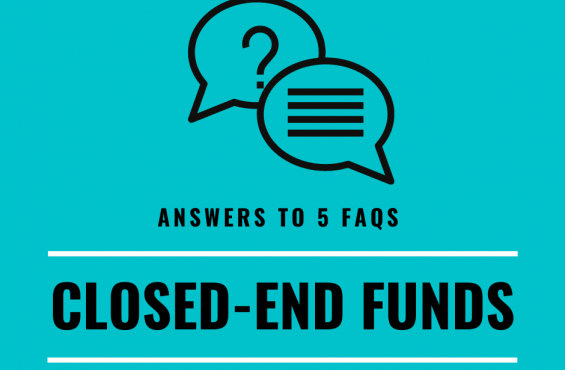Investors are hunting for any signs of yield in today’s low-yield environment, and that’s led some investors into the world of closed-end funds, which tend to have higher yields.
Are closed-end funds a good place to put your cash in this market? How do closed-end funds generate decent yields?
Some investors wonder if closed-end funds are a good place to put their cash. FundX investment advisors answered five closed-end fund FAQs to help investors better understand closed-end funds.
Here’s what fund investors should know about closed-end funds (and interval funds)
The vast majority of funds are open-end mutual funds and exchange traded funds. Closed-end funds represent a small fraction of the fund universe. Data from the 2021 ICI Factbook.

What’s the difference between open-end and closed-end funds?
Most mutual funds are structured as open-end funds, meaning that these funds continually offer and redeem shares. For every share that is purchased, a new share is created, and for every share that is redeemed, an existing share is cancelled out.
This creation and redemption process provides ample liquidity: investors know that if an open-end fund they own isn’t doing well, they can sell it at the fund’s net asset value (NAV), and move on to another fund.
Closed-end funds have a fixed number of shares, determined at an initial offering, and these shares are traded between investors (the fund itself doesn’t issue or redeem shares). Because there are only a limited number of shares available, closed-end funds have less liquidity. You can only sell your shares if a buyer is available, and shares don’t always trade at NAV.
Closed-end funds “usually trade at a discount to NAV. While it is attractive, in theory, to pay 90 cents for a dollar of assets, investors might never see the extra dime,” Barron’s reported.
Are closed-end funds a good investment?
Most investors want liquidity: they want to be able to move on if an investment isn’t performing well or if the market sours, and that can be hard to do with closed-end funds.
If a closed-end fund isn’t performing well, you will only receive as much as a buyer is willing to pay for those shares, and you may have to sell your shares at a discount to the value of the underlying securities.
A May 2021 Investment Company Institute study found that these discounts can be particularly large when markets are under pressure. During the Covid crash in March 2020, equity closed-end funds traded 11% less than their NAV on average, and bond closed-end funds traded at an average 7% discount.
How do closed-end funds generate higher yields?
Closed-end funds don’t have to keep cash on hand or worry about selling their investments in order to meet shareholder redemptions, so they can have more invested in less liquid securities, such as private companies, municipal bonds, or cryptocurrencies, which may have higher growth or income potential. Open-end funds, on the other hand, are limited to 15% invested in illiquid securities.
Closed-end funds may use leverage to boost yields. “Closed-end funds generally offer higher yields than open-end, often increased by borrowing, which also adds to risk” the Wall Street Journal explained, noting that when energy prices plunged in 2020, “several energy funds were forced by their use of borrowing to sell assets or liquidate.”
What are interval funds?
Interval funds are a type of closed-end fund that have some of the attributes of open-end funds. Interval funds continually offer shares to investors like open-end funds, and they also redeem (“repurchase”) shares at predetermined times (or intervals, hence the name).
Investors still face a number of trading restrictions, however. First, interval funds only repurchase a limited number of outstanding shares (5%-25%) at each interval, so investors may not be able to redeem any or all of their shares.
As the SEC put it, “You will not be able to sell your fund shares whenever you want. You must wait for the next repurchase offer, which could be as long as twelve months away. Your money may be locked up in the fund, even in the event of a market downturn.”
Second, investors also have to accept the fund’s repurchase offer up to 14 days before the repurchase date, so they won’t know the price they’ll receive for their shares ahead of time. On the plus side, shares are redeemed at the fund’s net asset value (NAV), not at a premium or a discount.
Finally, investors may be charged a redemption or repurchase fee (up to 2%), and repurchases can take one to seven days to settle, so they could be out of the market for a week.
Should you invest in closed-end funds?
Here at FundX, we typically stick with liquid, open-end funds because they enable us to actively respond when markets change.
If you decide to use closed-end funds, make sure you have a strategy to help you select which funds to own and know when it’s time to move on to other funds.
Still have questions about closed-end funds? Let us know.
